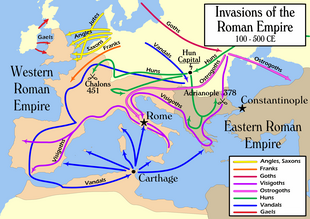
Civilization
A civilization (British English: civilisation) is any complex society characterized by the development of the state, social stratification, urbanization, and symbolic systems of communication beyond natural spoken language (namely, a writing system).[2][3][4][5][6]
For other uses, see Civilization (disambiguation).
Civilizations are often characterized by additional features as well, including agriculture, architecture, infrastructure, technological advancement, a currency, taxation, regulation, and specialization of labour.[5][6][7]
Historically, a civilization has often been understood as a larger and "more advanced" culture, in implied contrast to smaller, supposedly less advanced cultures.[8][9][10][11] In this broad sense, a civilization contrasts with non-centralized tribal societies, including the cultures of nomadic pastoralists, Neolithic societies, or hunter-gatherers; however, sometimes it also contrasts with the cultures found within civilizations themselves. Civilizations are organized densely-populated settlements divided into hierarchical social classes with a ruling elite and subordinate urban and rural populations, which engage in intensive agriculture, mining, small-scale manufacture and trade. Civilization concentrates power, extending human control over the rest of nature, including over other human beings.[12]
The word civilization relates to the Latin civitas or 'city'. As the National Geographic Society has explained it: "This is why the most basic definition of the word civilization is 'a society made up of cities.'"[13]
The earliest emergence of civilizations is generally connected with the final stages of the Neolithic Revolution in West Asia, culminating in the relatively rapid process of urban revolution and state formation, a political development associated with the appearance of a governing elite.
Civilizations are traditionally understood as ending in one of two ways; either through incorporation into another expanding civilization (e.g. as Ancient Egypt was incorporated into Hellenistic Greek, and subsequently Roman civilizations), or by collapsing and reverting to a simpler form of living, as happens in so-called Dark Ages.[83]
There have been many explanations put forward for the collapse of civilization. Some focus on historical examples, and others on general theory.
Non-human civilizations[edit]
The current scientific consensus is that human beings are the only animal species with the cognitive ability to create civilizations that has emerged on Earth. A recent thought experiment, the silurian hypothesis, however, considers whether it would "be possible to detect an industrial civilization in the geological record" given the paucity of geological information about eras before the quaternary.[100]
Astronomers speculate about the existence of communicating intelligent civilizations within and beyond the Milky Way galaxy, usually using variants of the Drake equation.[101] They conduct searches for such intelligences – such as for technological traces, called "technosignatures".[102] The proposed proto-scientific field "xenoarchaeology" is concerned with the study of artifact remains of non-human civilizations to reconstruct and interpret past lives of alien societies if such get discovered and confirmed scientifically.[103][104]
